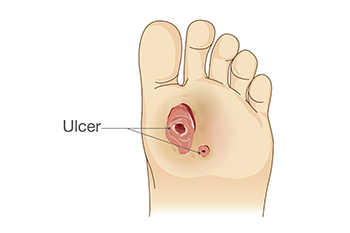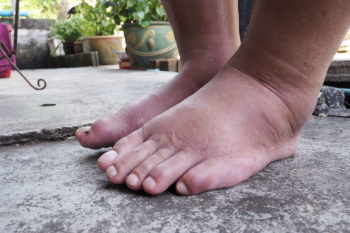
A diabetic foot ulcer is an open wound that develops when high blood sugar levels affect circulation and nerve function in the feet. These changes make the skin more vulnerable to injury and slow the body’s ability to heal. Ulcers often begin as a small blister, callus, or unnoticed cut, especially in areas that bear pressure. As sensation decreases, many people do not feel pain, allowing the wound to worsen before it is discovered. Early recognition is essential because untreated ulcers can lead to infection and more complex complications. Regular foot checks, proper footwear, and prompt attention to any skin changes help protect overall foot health. A podiatrist can evaluate the ulcer, determine its severity, and recommend appropriate treatment to promote healing. If you notice an open sore on your foot, it is suggested that you see a podiatrist for timely care.
Wound care is an important part in dealing with diabetes. If you have diabetes and a foot wound or would like more information about wound care for diabetics, consult with Joseph Creswell, DPM from Practice. Our practitioner will assess your condition and provide you with quality foot and ankle treatment.
What Is Wound Care?
Wound care is the practice of taking proper care of a wound. This can range from the smallest to the largest of wounds. While everyone can benefit from proper wound care, it is much more important for diabetics. Diabetics often suffer from poor blood circulation which causes wounds to heal much slower than they would in a non-diabetic.
What Is the Importance of Wound Care?
While it may not seem apparent with small ulcers on the foot, for diabetics, any size ulcer can become infected. Diabetics often also suffer from neuropathy, or nerve loss. This means they might not even feel when they have an ulcer on their foot. If the wound becomes severely infected, amputation may be necessary. Therefore, it is of the upmost importance to properly care for any and all foot wounds.
How to Care for Wounds
The best way to care for foot wounds is to prevent them. For diabetics, this means daily inspections of the feet for any signs of abnormalities or ulcers. It is also recommended to see a podiatrist several times a year for a foot inspection. If you do have an ulcer, run the wound under water to clear dirt from the wound; then apply antibiotic ointment to the wound and cover with a bandage. Bandages should be changed daily and keeping pressure off the wound is smart. It is advised to see a podiatrist, who can keep an eye on it.
If you have any questions please contact our office located in Wallace, ID . We offer the newest diagnostic and treatment technologies for all your foot and ankle needs.

A bunion develops when the big toe gradually shifts toward the smaller toes, causing a noticeable bump on the side of the foot and irritation around the big toe joint. This change, known medically as hallux valgus, often leads to soreness in the toes, redness around the joint, and areas of thickened skin under the ball of the foot. Some people experience numbness if nearby nerves become irritated, and stiffness in the big toe can make walking uncomfortable. Shoes that lack adequate support or have narrow designs often increase pressure on the joint. A podiatrist can evaluate the alignment of the toes, check joint movement, and recommend a treatment plan. Supportive footwear with a wide toe box, custom orthotics, and padding can ease pressure on the joint, while surgery corrects the underlying misalignment when pain is severe. If you have a painful bunion, it is suggested that you make an appointment with a podiatrist for a diagnosis and treatment.
If you are suffering from bunion pain, contact Joseph Creswell, DPM of Practice. Our practitioner can provide the care you need to keep you pain-free and on your feet.
What Is a Bunion?
Bunions are painful bony bumps that usually develop on the inside of the foot at the joint of the big toe. As the deformity increases over time, it may become painful to walk and wear shoes. Women are more likely to exacerbate existing bunions since they often wear tight, narrow shoes that shift their toes together. Bunion pain can be relieved by wearing wider shoes with enough room for the toes.
Causes
- Genetics – some people inherit feet that are more prone to bunion development
- Inflammatory Conditions - rheumatoid arthritis and polio may cause bunion development
Symptoms
- Redness and inflammation
- Pain and tenderness
- Callus or corns on the bump
- Restricted motion in the big toe
In order to diagnose your bunion, your podiatrist may ask about your medical history, symptoms, and general health. Your doctor might also order an x-ray to take a closer look at your feet. Nonsurgical treatment options include orthotics, padding, icing, changes in footwear, and medication. If nonsurgical treatments don’t alleviate your bunion pain, surgery may be necessary.
If you have any questions, please feel free to contact our office located in Wallace, ID . We offer the newest diagnostic and treatment technologies for all your foot care needs.

Swollen feet can not only be uncomfortable but also may signal underlying health issues that require attention. Common causes include diabetes, liver damage, kidney damage, or infections in the feet that lead to inflammation and fluid buildup. Swelling may present as tight, heavy, or tender feet and can interfere with daily activities. A podiatrist can help by identifying the root cause of the swelling, evaluating foot health, and recommending treatments to reduce discomfort and prevent complications. This may include specialized footwear, wound care, and exercises to improve circulation. Early intervention is key to protecting your feet and overall health. If you have swollen feet, it is suggested that you schedule an appointment with a podiatrist who can offer you effective relief and treatment solutions.
Swollen feet can be a sign of an underlying condition. If you have any concerns, contact Joseph Creswell, DPM of Practice. Our practitioner can provide the care you need to keep you pain-free and on your feet.
Swollen feet are a common ailment among pregnant women and people who stand or sit for extended periods. Aging may increase the possibility of swollen feet and patients who are obese often notice when their feet are swelling too. There may be medical reasons why swollen feet occur:
- Phlebitis - A condition that causes the veins to become inflamed and can also cause leg pain.
- Liver disease - This may lead to low blood levels of albumin which is a protein. This can cause fluid in the blood to pass into the tissues and several areas of the body can become swollen.
- Heart failure - When the heart doesn’t pump properly the blood that is normally pumped back to the heart can pool in the veins of the legs causing swollen feet.
- Kidney disease - One of the main functions of the kidneys is releasing excess fluid in the body. This type of condition can make it difficult for the kidneys to function properly, and as a result the feet may become swollen.
- Deep-vein thrombosis (DVT)- This is a serious condition where blood clots form in the veins of the legs. They can block the return of blood from the legs to the heart which may cause the feet to swell. It is important to be treated by a podiatrist if this condition is present.
Swollen feet can also be caused by bone and tendon conditions, including fractures, arthritis, and tendinitis. Additionally, there may be skin and toenail conditions and an infection may cause the feet to swell. Patients who take medicine to treat high blood pressure may be prone to getting swollen feet.
Many patients elevate their feet to help relieve the swelling and this is generally a temporary remedy. When a podiatrist is consulted the reason behind the swelling can be uncovered and subsequently treated.
If you have any questions please contact our office located in Wallace, ID . We offer the newest diagnostic and treatment technologies for all your foot and ankle needs.

